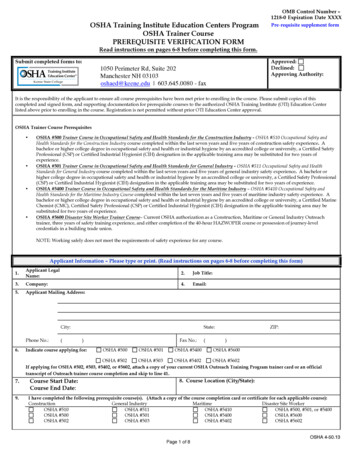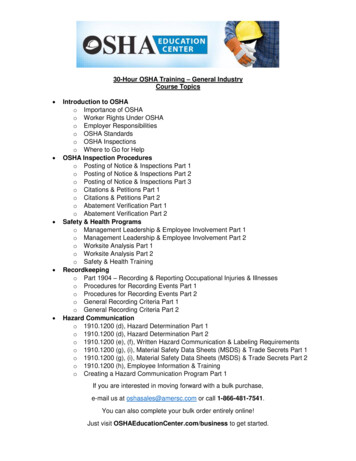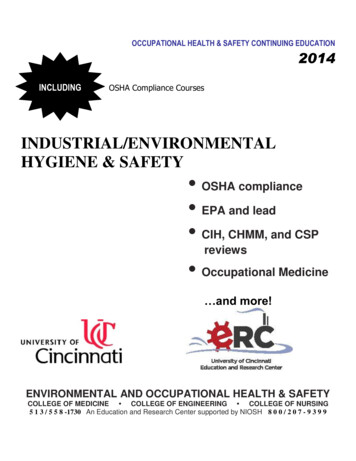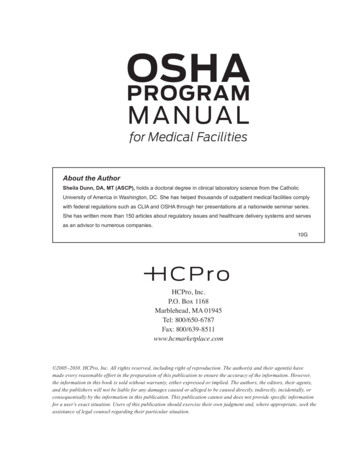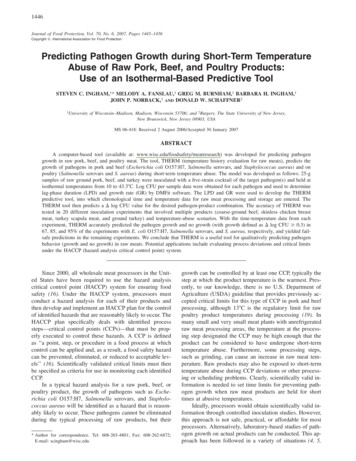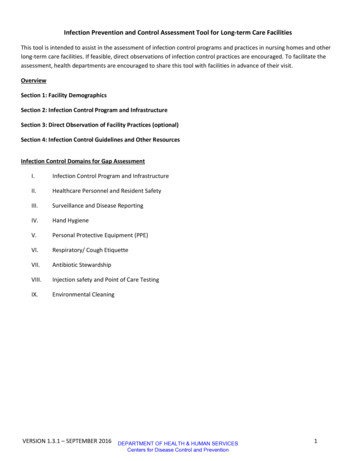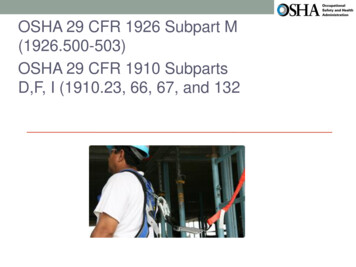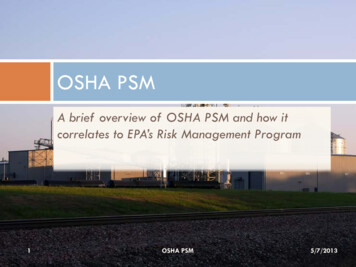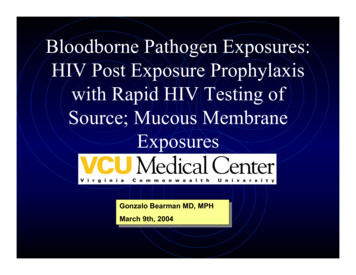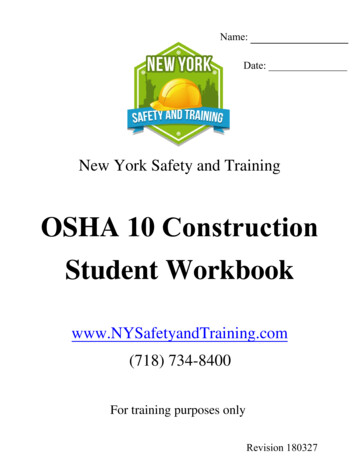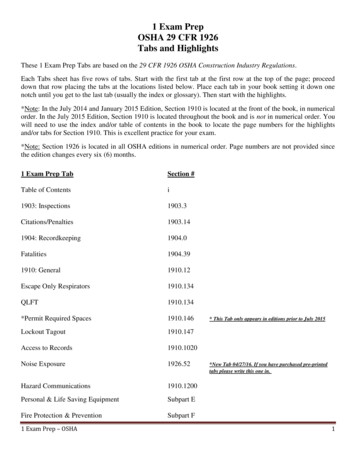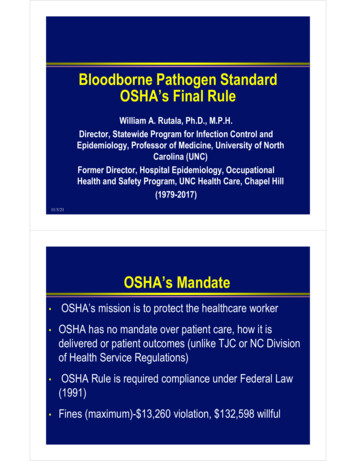
Transcription
Bloodborne Pathogen StandardOSHA’s Final RuleWilliam A. Rutala, Ph.D., M.P.H.Director, Statewide Program for Infection Control andEpidemiology, Professor of Medicine, University of NorthCarolina (UNC)Former Director, Hospital Epidemiology, OccupationalHealth and Safety Program, UNC Health Care, Chapel Hill(1979-2017)11/3/21OSHA’s Mandate OSHA’s mission is to protect the healthcare worker OSHA has no mandate over patient care, how it isdelivered or patient outcomes (unlike TJC or NC Divisionof Health Service Regulations) OSHA Rule is required compliance under Federal Law(1991) Fines (maximum)- 13,260 violation, 132,598 willful
Occupational Exposure to Bloodborne Pathogen Standard, 1991Revised CPL Enforcement Document - 2001BBP Standard Scope and Application Applies to all employees with occupational exposure to blood orother potentially infectious materials (OPIM) and includes: All private sector employeesAll public sector employeesStudents receiving compensation (teaching/graduate assistants,internships)Does not include: Self-employed persons Includes sole practitioners and partnersStudents not receiving compensationOther employees covered by other federal statutes
Employees Potentially At Risk Physicians and surgeonsNursesPhlebotomistsMedical examinersDentists and dentalworkers Clinical/diagnosticlaboratory workersMedical technologistsNursing home personnelDialysis personnelLaundry andhousekeepingemployeesTypes of Occupational Exposures toBloodborne Pathogens Percutaneous injury (PI) Mucous membrane Non-intact skin
Infection Control ProgramComponentsDevelop written institutional Exposure Control Plan Exposure DeterminationControl MethodsUniversal (Standard) Precautions Engineering Controls Work Practice Controls Personal Protective Equipment Infection Control ProgramComponents (cont) HBV VaccinationPost-Exposure Evaluation and Follow-upRegulated Waste DisposalTags, Labels, and BagsHousekeeping PracticesLaundry PracticesTraining and Education of EmployeesRecord Keeping
Exposure DeterminationConsiderations Employer shall identify all employees who are directlyexposed or whose jobs have the likelihood ofexposures to blood or other potentially infectiousmaterials (OPIM)Employer shall make an exposure determinationwithout regard to use of personal protective equipment(PPE)Fluids Recognized by CDC as DirectlyLinked to Transmission of HBV and/or HIVbloodbloody body fluidssemenvaginal secretionsamniotic fluidsaliva in dental settingscerebrospinal fluidsynovial fluidpleural fluidperitoneal fluidpericardial fluid
Bloodborne Pathogens Pathogenic organisms that are present in human blood,and Can cause disease in humansIncludes but not limited to: Hepatitis B virus (HBV) Hepatitis C virus (HCV) Human immunodeficiency virus (HIV)Other Bloodborne Pathogens(linked to blood exposures) Malaria Syphilis Babesiosis (protozoan) Brucellosis Leptospirosis Staphylococcus aureus Arboviral infections (spread bymosquitoes and ticks-West Nile) Relapsing fever-tickborne Human T-Lymphotrophic VirusType 1 and 2 Viral hemorrhagic fevers (includesEbola, Marburg, Lassa fever,yellow fever viruses)
OSHA Enforcement Revisions Provider Services Shared responsibility between the contract provider and the hostemployer to ensure compliance with OSHA standards.Contract provider (who send their employees to work at otherfacilities to be employers) is responsible for providing: General bloodborne pathogen trainingAppropriate vaccinationsFollow-up evaluations to exposure incidentsHost employer is responsible for providing: Site-specific trainingPersonal protective equipment (PPE)Control of potential hazards and exposure conditionsOSHA Enforcement Revision –Exposure Control Plan Reviewed and updated annually* (new or modifiedtasks, procedures, equipment)Procedure to evaluate circumstances surroundingexposure incidentsUse of Body Substance Isolation or StandardPrecautions is acceptable as long as all provisions ofstandard are adhered to.* Annual 365 days from last review
Control MeasuresUniversal Precautions“Universal (standard-used for all patients)precautions” refers to a method of infection controlin which all human blood and OPIM are treated asif known to be infectious with HIV and HBV.Universal precautions does not apply to feces,nasal secretions, sputum, sweat, tears, urine orvomitus unless they contain visible blood.Control MeasuresEngineering ControlsUse of available technology and devices to isolate orremove hazards from the workerConsiderations: Engineering Controls should be used in preference to other controlmethods must be examined and maintained or replaced on aregular scheduled basis to ensure theireffectiveness
Examples of Engineering Controls(only acceptable reason for not choosing a safety device is patient safety; mustbe evaluated by HCF to replace non-safety devices) Needleless IV systemsLasers (in place of scalpels), staples (not sutures)One-way cardiopulmonary resuscitation (CPR) airwaymasksHandwashing facilities placementSharps containers (do not have to walk for disposal)Self-sheathing needlesBlunted sutures/sutureless products when appropriate (e.g.,blunt safety needles cannot be used safely on surgery of alltypes)Safety scalpel that are disposalOSHA Enforcement Revision –Evaluation of Devices The employer must: Review and evaluate available and newengineering control devices on an annual basis Train employees on safe use and disposal Implement use of appropriate engineering controlsand devices Document evaluation and implementation in theexposure control plan (ECP)
Needlestick Safety and Prevention ActNovember 2002 Directs OSHA to revise BBP standard to clarifyrequirement for employers to evaluate safer needles andinvolve employees in identifying and choosing devicesRequires documentation of frontline providerparticipation in the evaluation of safety devices anddecision making in product purchasing.Required to document any difficulties in implementingsafety devices such an interference with medicalprocedures or not availableOSHA Enforcement Revision - Action List Collect data on device-related injuries includinghow exposure occurred . . .type (puncture vs cut) and brand of device circumstances of injury (what time of day, location) job category of injured provider Purpose is to use information on injuries to guidethe selection and implementation of safety devicesfor your facility
Control MeasuresWork Practice ControlsAlterations in the manner in which a task is performed toreduce likelihood of exposureConsiderations: Work Practice Handwashing ASAP after glove removal or contact withbody fluidsAll PPE removed ASAP after leaving work area and placedin designated container for storage, decontamination, ordisposalUsed needles and sharps shall not be sheared, bent,broken, recapped or resheathed by hand.
Control MeasuresWork Practice ControlsConsiderations: Work Practice (cont)All procedures performed to minimize splashing andspraying Prohibit eating, drinking, smoking, applying cosmetics orlip balm in work areas where reasonable chance ofexposure Prohibit storage of food and drink in refrigerators orfreezers, shelves, cabinets or countertops or benchtopswhere blood or OPIM are present Personal Protective Equipment(PPE) PPE is the last in thehierarchy of controlmeasures.Gloves, masks, protectiveeyewear
Personal Protective EquipmentSpecialized clothing or equipment used by workers to protectthemselves from direct exposure to blood or OPIMConsiderations: PPEEmployer shall provide and assure employee use ofappropriate PPE such as gloves, gowns, laboratory coats,fluid resistant aprons, face shields, or masks, eye protectionand mouthpieces, resuscitation bags, pocket masks or otherventilation devices Change if visibly soiled “Assure”-policy in place for disciplinary action: first offense-warning; second offense-reeducation; third offense-affect merit raise; fourth offense-terminationPersonal Protective Equipment(cont)Equipment shall be available in a variety of sizes andreadily accessible Employer provides for the cleaning, laundering or disposalof all PPE Disposable gloves replaced when visibly soiled, torn, orpunctured, and shall not be washed or disinfected for reuse. Utility gloves may be cleaned and disinfected for reuse ifthey show no signs of deterioration
Recommendations for GlovingRemove gloves thatare torn, cut or puncturedDo not wash, disinfector sterilize gloves for reuseGloves Gloves are worn for three reasons: Tominimize the risk of health care personnel acquiringinfections from patients. Toprevent pathogenic organisms from being transmittedfrom health care personnel to patients. Toreduce contamination of health care personnel'shands by organisms that can be transmitted from onepatient to another
Protective Face Masks, Surgical Masks,and Eye Guards Required when contamination of mucous membranes ofeyes, nose and mouth with body fluids may occur throughsplashes or aerosolization of these fluids.Prescription glasses may be used as protective eyewearas long as they are equipped with solid side shields.If protective eyewear is chosen over the use of a faceshield, the eyewear must be worn in combination with amask to protect the nose and mouth.HBV Vaccination HBV vaccination shall be offered, at no cost, aftertraining and within 10 days of initial job assignment, toall employees whose jobs include risk of directlycontacting blood or OPIMVaccinations shall be given according torecommendations for standard medical practiceA declination form must be signed by employee whorefuses the HBV vaccination (including those who donot complete the 3 shot series)
Post-Exposure Management Program Clear policies and procedures on how to manage employeesEducation of healthcare workers including principles of postexposure management, importance of prompt reporting, PEPefficacy/toxicityResources for rapid access to Clinical care Post-exposure prophylaxis (PEP) Testing of source patients/HCP
Post-Exposure Evaluation andFollow-upWithin 15 days following report of an exposure incident, theemployer shall make available to employee a confidentialmedical evaluation and follow-up Employer shall document the route of exposure, HBV andHIV status of the source patient, if known, and thecircumstances under which the exposure occurred Employer shall notify the source patient of the incident,obtain consent if necessary and test the source for HIV orHBV unless known positive Post-Exposure and EvaluationFollow-up Employer shall offer to collect a blood sample from the exposedworker ASAP to test for HIV and or HBV status (if requested,must hold for 90 days)Employer shall offer HIV testing of baseline, 6 weeks, and 6months after exposureFollow-up shall include counseling, medical evaluation of anyfebrile illness that occurs within 12 weeksPost-exposure prophylaxis when indicated, as recommended byUS Public Health Service (PEP for HIV ASAP, must be 72hours)
OSHA’s Definition of Medical WasteOSHA states “regulated waste” is (1) liquid or semi-liquidblood or other potentially infectious material; (2)contaminated items that would release blood or OPIM in aliquid or semi-liquid state if compressed; (3) items that arecaked with dried blood or OPIM and are capable ofreleasing these materials during handling; (4)contaminated sharps; and (5) pathological andmicrobiological wastes containing blood or OPIM
Regulated Medical Waste (RMW) DisposalDisposal of RMW shall be in accordance with allapplicable federal, state, and local regulations All RMW shall be placed in closable, leakproofcontainers, or bags that are color-coded, labeled ortagged Disposable syringes, needles, scalpel blades andother sharp items shall be placed in punctureresistant containers for disposal Regulated Medical Waste Disposal (cont) Puncture-resistant sharps containers shall be easilyaccessible to workers and located in areas where they arecommonly usedDouble-bagging prior to handling, storing, and/ortransporting is necessary if the outside of the bag iscontaminatedLab specimens of body fluids shall be transported in acontainer that will prevent leaking and disposed of inaccordance with institutional policies and regulatoryrequirements
Tags, Labels, and Bags Tags that are orange-red in color with a contrastingbackground are acceptableTags shall contain the word “BIOHAZARD” or thebiological hazard symbol andState the specific hazardous condition or theinstructions to be communicatedWord and message must be understandable to all
Tags, Labels, and Bags (cont)Label tags may be part of container or affixed asclosely as possible by wire or adhesive to prevent theirlossRed bags or red containers may be substituted forlabels on containers of Regulated Medical WasteAll employees must be informed of meaning oflabels/tags Handling Specimens Employers may avoid labeling only if all employeeswho have contact with specimen containers canrecognize them as requiring Universal Precautionsand the employees have been trained to followUniversal PrecautionsEmployers must label or color-code specimencontainers whenever they leave the facility
Housekeeping Practices Employer shall assure that the worksite is maintained in aclean and sanitary conditionEmployer shall determine and implement an appropriatecleaning schedule for rooms where BBP are depending on thesite, type of surface, and amount of soil presentEmployer shall ensure that housekeepers wear appropriatePPE including general purpose utility gloves during allcleaning of BBP and decontamination proceduresHousekeeping Practices (cont) Initial clean-up of blood or OPIM shall be followed withthe use of an EPA-approved hospital disinfectantchemical germicide that has either a tuberculocidal orHIV/HBV label claim or a solution of 5.25% sodiumhypochlorite (household bleach) diluted between 1:10and 1:100 with waterEquipment contaminated with blood or OPIM shall bedecontaminated if possible prior to servicing or shipping
Laundry Practices The employer shall ensure that laundry workers wearprotective gloves and other appropriate PPE duringhandling and sorting of linen.Contaminated laundry shall be bagged at the location ofuse and not sorted or rinsed in patient areas.Contaminated laundry shall be placed and transported inbags that are labeled or color-coded that prevent leakage.When a facility uses UP in the handling of all soiledlaundry, alternative labeling is acceptable if recognizable byall workers.
Provider Education and Training Strategies to preventoccupational exposure toblood Importance of reportingexposure incidents New employee orientation Annual inservices New procedure or equipmentTraining Employers must train at-risk employee at no costand on paid timeMust train at time of initial assignment and at leastannually thereafter, or if new occupationalexposure
Training (cont) Training program must includeaccessible copy of regulatory text of standard andexplanation general epidemiology and symptoms of BBP explanation of modes of transmission explanation of employer’s exposure control planand how to get a copy Training (cont) Training program must includeexplanation of appropriate methods for recognizingtasks that may involve exposure explanation of the use and limitations of methods toprevent exposures info on types, use, locations, removal, handling of PPE explanation of basis for selection of PPE
Training (cont) Training program must includeinfo on actions and persons to contact for exposure toBBP method for reporting on exposure incidents info on post-exposure evaluation and follow-up explanation of signs and labels opportunity to question trainer about standard;therefore, training cannot be totally by videotape Recordkeeping The employer must keep training records with thefollowing information:The dates of the training session The contents or a summary of the training session The names and qualifications of the persons conductingthe training The names and job titles of all persons attending thetraining sessions Employers must keep these records for 3 years fromthe date of the training session
Federal Legislation on Needle Safety Bloodborne Pathogens Standard amended withNeedlestick Law requirements (Federal RegisterJanuary 18, 2001)Defining “engineering controls” Exposure control plan requirements Soliciting employee input Recordkeeping Exposure Control Plan Requirements In annual review of ECP employers must considerinnovations in procedure or technologicaldevelopments that reduce the risk of sharpsexposure.Must state methods used to evaluate andjustification for decisions on safety devices.
Blood Exposures 2019 Source Positive for BBP 13.4% (67/500) HBV-0.2% (1/500)HIV-4.6% (23/500)HCV-8.6% (43/500)
Impact of Safety-Engineered Devices on theIncidence of BBP Exposures at UNC HospitalsKanamori et al. ICHE. Feb 2016Overall BBP exposures and incidence of percutaneous injuries reducedImpact of Safety-Engineered Devices on theIncidence of BBP Exposures at UNC HospitalsKanamori et al. ICHE. Feb 2016Incidence rate associated with percutaneous devices significantly reduced andpercutaneous injuries associated with safety-engineered devices increased
Impact of Safety-Engineered Devices on theIncidence of BBP Exposures at UNC HospitalsKanamori et al. ICHE. Feb 2016The incidence rate for overall BBP was significantly reducedSoliciting Employee Input Employers must invite participation of nonmanagerial employees who are potentiallyexposed to sharps injuries to participate inidentification, evaluation and selection ofengineering and work practice controls.Explain in exposure control plan how employersolicited employee participation.
OSHA Enforcement Revisions Home HealthThe American Dental Association v. Martin decision upheldthe bloodborne pathogen standard but restricted itsapplication in home health services provided in privatehomes. . .feasibility of off-site control not appropriate. . .OSHA may not cite employers when hazard is sitespecific (housekeeping requirements such as clean andsanitary worksite, handling and disposal of regulatedwaste, ensuring use of PPE, engineering controls andhandwashing)OSHA Enforcement Revision - HomeHealth (cont) The employer will be held responsible for all nonsite specific requirements of the exposure controlplanhepatitis B vaccination post-exposure evaluation and follow-up recordkeeping generic training requirements appropriate supply of PPE
OSHA’s Mandate OSHA’s mission is to protect the healthcareworker OSHA Rule is required compliance under FederalLaw
employer shall make available to employee a confidential . Post-exposure prophylaxis when indicated, as recommended by US Public Health Service (PEP for HIV ASAP, must be 72 hours) OSHA's Definition of Medical Waste OSHA states "regulated waste" is (1) liquid or semi-liquid
